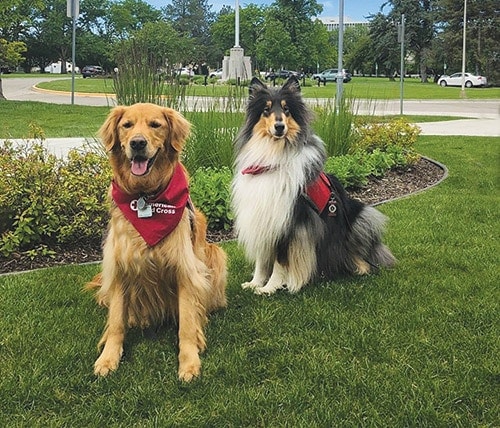
The nurses and other health-care staff seemed somewhat downcast when the three of us with our therapy dogs breezed through the doors of the VA medical center’s hospice unit. We’d already visited the patients in the center’s rehab facility. Ivy, the black Maltese; Winston, the tricolored collie; and my golden retriever, Brody, had provided a pleasant distraction to the residents by happily meeting and greeting each one. We’d now moved on to hospice, looking forward to seeing some of our “regulars.” The news the staff shared, however, was disheartening.
“We’ve lost nine patients in the past 13 days,” they said. “We’re feeling sad today.”
The health-care professionals who work in hospice units are well prepared to deal emotionally with the passing of their patients. But we’re all still human, and it’s difficult not to become attached to these dear people. I haven’t been doing dog therapy at the VA medical center as long as some others, but I clearly remembered a couple of the patients, now gone. The man who loved to watch the birds eating at the feeder outside his window. The woman who was so over-the-top thrilled to see the dogs that it brought tears to my eyes. I’m glad we had the opportunity to visit them, I thought.
Because we’re not trained counselors or chaplains, we’re instructed not to discuss personal medical conditions, politics, or religion with hospital and nursing home residents. We’re there to handle the dogs, we’re told, and to have cheerful, “light” discussions. I view my dog therapy work as a ministry, but I’ve been asked how I can consider it as such when “all we do is let people pet our dogs.” We’re not giving Bible studies or preaching sermons or teaching vegetarian cooking classes. Can this really be a ministry?
I’ve determined that the answer is yes. Even though it’s a “small” ministry, I believe that God can communicate His unconditional love even through His four-legged creatures who speak only in “canine.”
In one nursing home an elderly man was slumped over in his wheelchair in the hallway. Even though I expected he would be unresponsive, I asked him if he would like to say hello to Brody. Surprisingly, he very slowly lifted his head, opened his eyes, then reached out and wrapped his arms around Brody. Tears flowed down his face. I attempted a conversation, but he never did speak. He only hung on to the dog. I truly believe the Lord knew he needed a visit from a dog that day. I also remember going to a high school following a teen suicide. What struck me was that no prayers were offered, no encouragement from God’s Word was shared. Amid tragedies in our Adventist school system we can point to the One who provides needed hope and strength, but not so in this environment. As I watched the teens hug and cry on the dogs, however, I still felt the Holy Spirit was there, sharing God’s love and His own brokenness of heart through the dogs.
Pet therapy may not be one of the more overt ways to minister to others, but God uses many methods—even small ones—to reach His children.
To read about the physical and emotional benefits of pet therapy, go to www.uclahealth.org/pac/animal-assisted-therapy.
Sandra Blackmer is an assistant editor of Adventist Review.